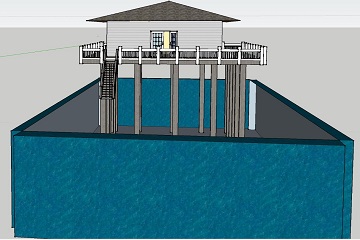Prevented Flood, Students of IPB Created the Integrated Water Channel

Capital of Indonesia, Jakarta, was not free from the threat of the flood that at times could attack. According to the historical record of Jakarta, it had been flooded since 1962, and the worst flood was occurred in February 1918. Moreover, when the rainy season had arrived, it would be very disturbing the people of Jakarta. In connection with how to try to cope with the flood, then there were some problems causing the flood such as the waste problem, the high rainfall, the water overflow, and the destruction of dams to the problems of illegal and densely populated settlements. Other than that, it would cause the economy to become paralyzed, the damage to settlement, the disease outbreak, and other infrastructures that could not operate.
Students of the Computer Engineering of IPB created the solution to overcome the flood problem called “Saiter”. Saiter provided the alternative solution in form of the innovation that helped solve the flood problem. Saiter or which could be called by “Saluran Air Terintegrasi / Integrated Water Channel” was designed in such a way that when the rain with the high intensity, the water could be channeled towards the end point of the disposal, and it was expected to help reduce the flood problem with this irrigation system.
Rifqi Dias and four students of Diploma of IPB tried to provide the benefit, especially in the field of the environment through Saiter. Rifqi as the Chairman of the Student Creativity Program (PKM) said, Saiter had several important components namely the main components in form of the framework of the water level monitoring system (the monitoring of the water volume), the grinding and the filtration (the particle destruction and filtering), the mini rotary turbine (the turbine drive), the smart grid (the regulator of the energy usage), and the resources (the energy storage). All of these components would be incorporated into the design and the model of the modern stage house design architechture.
The flood water would enter through the water monitoring which would automatically be monitored. Then it would go into the shelter and would move the filtration and the grinding which served to filter out to prevent the clogging by the waste and to do the destruction of the waste particle.
“If the water in the shelter is full, then it will be integrated into other channels or to landfills (reservoirs, dams, and fields). While the mini rotary turbine works to move the turbine as the kinetic energy, and it is channeled to the smart grid as well as the generated electricity will be stored into the resource,” said Rifqi.
Saiter was made using the components that were resistant to the wet conditions, thus it minimized from corrosive and shorted. The main target of this innovation was the big cities in Indonesia that often experienced the flooding problems.
Rifqi hoped that in the future the technology of Saiter would continue to evolve and innovate, so that it was not only a solution to the problem of flooding in Jakarta but it would also be able to exploit the flooding as the electric energy generator.(AT/Zul)



